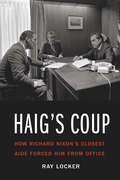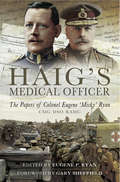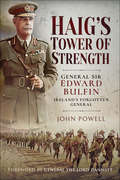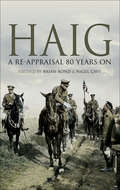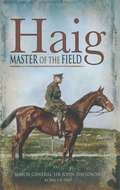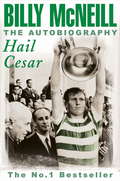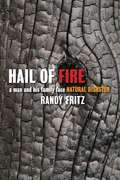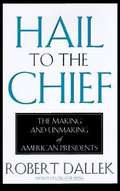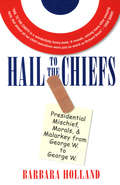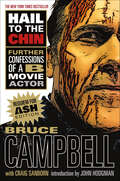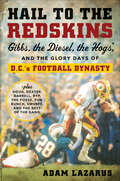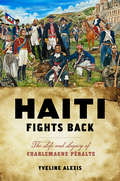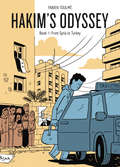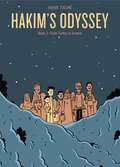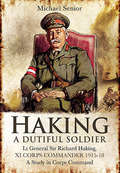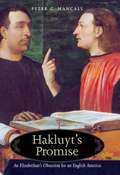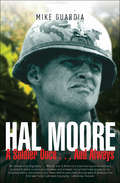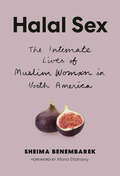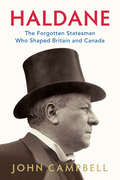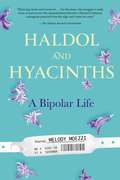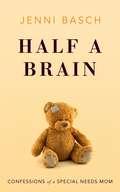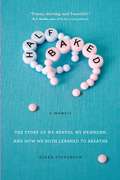- Table View
- List View
Hadrian the Seventh
by Frederick Rolfe'If there be one place in all this orb of earth where a secret is a Secret, that place is a Roman Conclave' Part novel, part daydream, part diatribe, this strange masterpiece tells the story of George Arthur Rose, a poor, frustrated writer who lives in a shabby bedsit, saving his cigarette ends and eating soup - until one day he is made Pope. As the first English pontiff in five centuries, he is a mass of contradictions: infallible and petulant, humble and despotic. Yet Hadrian the Seventh is really a knowing self-portrait of its flamboyant author Baron Corvo, a would-be priest with aristocratic pretensions, and one of the greatest eccentrics of English literature.
Haig's Coup: How Richard Nixon's Closest Aide Forced Him from Office
by Ray LockerWhen General Alexander M. Haig Jr. returned to the White House on May 3, 1973, he found the Nixon administration in worse shape than he had imagined. President Richard Nixon, reelected in an overwhelming landslide just six months earlier, had accepted the resignations of his top aides—the chief of staff H. R. Haldeman and the domestic policy chief John Ehrlichman—just three days earlier. Haldeman and Ehrlichman had enforced the president’s will and protected him from his rivals and his worst instincts for four years. Without them, Nixon stood alone, backed by a staff that lacked gravitas and confidence as the Watergate scandal snowballed. Nixon needed a savior, someone who would lift his fortunes while keeping his White House from blowing apart. He hoped that savior would be his deputy national security adviser, Alexander Haig, whom he appointed chief of staff. But Haig’s goal was not to keep Nixon in office—it was to remove him. In Haig’s Coup, Ray Locker uses recently declassified documents to tell the true story of how Haig orchestrated Nixon’s demise, resignation, and subsequent pardon. A story of intrigues, cover-ups, and treachery, this incisive history shows how Haig engineered the “soft coup” that ended our long national nightmare and brought Watergate to an end.
Haig's Medical Officer: The papers of Colonel Eugene 'Micky' Ryan CMG DSO RAMC
by Eugene RyanDespite countless conflicting assessments, Field Marshal Douglas Haig remains one of the most controversial and fascinating characters in British military history. To some he was a mindless butcher, to others a true patriot who masterminded Allied victory in the First World War under the most trying circumstances.The papers of Colonel Eugene 'Micky' Ryan, Haig's long serving doctor and confidant, are a significant find as they throw fresh and invaluable light on the life and character of this enigmatic man. Ryan studied medicine at Cork and Edinburgh. He was commissioned into the RAMC in 1901 and saw active service in South Africa. He first met Haig in 1912 and became Medical Officer to Haig's HQ 1st Corps in 1914 and moved with him to 1st Army that December. Ryan saw service commanding two Casualty Clearing Stations before being appointed Medical Officer to the C in C (Haig) in September 1916.Haig's and Ryan's relationship, while primarily professional, blossomed into a friendship of mutual respect and trust which lasted until Haig's death in 1928. Ryan delivered the Haigs' long awaited heir, Dawyck, in 1918 and advised during Dorothy Haig's illness in 1926.Fortunately Ryan kept meticulous diaries which, written from such a unique viewpoint and with constant reference to Haig and his family, are of historical importance: the Foreword, written by Professor Gary Sheffield a leading authority on Haig's life and work, attests to their significance.As seen in Britain at War Magazine, January 2014
Haig's Tower of Strength: General Sir Edward Bulfin—Ireland's Forgotten General
by John PowellThis is the first biography of General Sir Edward Bulfin, who rose to high rank despite his Catholic Irish republican background, at a time when sensitivities were pronounced. Not only that but by the outbreak of the Great War, Bulfin was a brigade commander despite having not attended Sandhurst or Staff College and never commanding his battalion.In his early career he was a protg of Bullers and he made his name in the Boer War. In 1914 Haig credited him with saving the day at First Ypres despite being wounded and gave him 28th Division. Unable to get on with Gough, he was sent home. He raised the 60th London Division and took it to France, Salonika and Egypt where Allenby chose him to command a corps. His success against the Turks at Gaza, Jerusalem and Megiddo justified Allenbys confidence.Despite ruthlessly crushing disturbances in post-war Egypt, Bulfins beliefs and background led him to refuse Churchills order to command the police and army in Ireland.A private man, Bulfin left few letters and no papers and the author is to be congratulated on piecing together this fascinating biography of an enigmatic military figure.
Haig: A Re-Appraisal 80 Years On
by Brian Bond, Nigel CaveField Marshal Earl Haig's reputation continues to arouse as much interest and controversy as ever. This volume represents the collaboration of two leading historical societies, The British Commission for Military History and The Douglas Haig Fellowship. Leading historians have produced a comprehensive and fascinating study of the most significant and frequently debated aspects of Haig's momentous career.
Haig: Master of the Field
by John P. DavidsonA distinguished soldier who had served in South Africa, the Author was selected to be Haigs Director of Operations in 1915, a key position he held until the end of the War. This book concentrates on the dramatic events of 1917 and 1918 and covers Third Ypres, the German onslaught (Kaiserschlacht), and the victorious 100 Days. We learn of the parlous state of the French Army, their loss of morale and the widespread mutinies.Tavish Davidsons viewpoint on the conduct of operations was unique and we learn of the factors at play in Haigs HQ. The German U-Boat fleets ports became a high priority as losses of shipping mounted, threatening the whole war effort. We get the German perspective Passchendaele 1917 was even more costly for them than the Allies.Davidson comes down wholeheartedly on Haigs side but this should not be a surprise as Haig was revered by his officers and men. It only became fashionable to pillory him much later.This is an important addition to the bibliography of the Great War.
Hail Cesar
by Billy McNeillFrom 1958-75 Billy McNeill was at the heart of everything Celtic did. An uncompromising but fair centre half, he captained the club for twelve hugely successful years. Later in his life he returned for two more periods as Celtic manager, winning the undying support of the club's legion of fans for his complete commitment to the cause. In this remarkable autobiography, he recalls the glory days of the Lisbon Lions alongside Bobby Lennox and Jimmy Johnstone; playing for Scotland with Billy Bremner and Denis Law; coming to England as a manager; and reveals just how good a babysitter Kenny Dalglish was. Told with great humour and intelligence, this is a fascinating story from one of Scotland's greatest heroes.
Hail Cesar
by Billy McNeillFrom 1958-75 Billy McNeill was at the heart of everything Celtic did. An uncompromising but fair centre half, he captained the club for twelve hugely successful years. Later in his life he returned for two more periods as Celtic manager, winning the undying support of the club's legion of fans for his complete commitment to the cause. In this remarkable autobiography, he recalls the glory days of the Lisbon Lions alongside Bobby Lennox and Jimmy Johnstone; playing for Scotland with Billy Bremner and Denis Law; coming to England as a manager; and reveals just how good a babysitter Kenny Dalglish was. Told with great humour and intelligence, this is a fascinating story from one of Scotland's greatest heroes.
Hail of Fire
by Randy FritzEvery year people watch in shock as homes are destroyed and communities devastated by natural disasters. As the media arrives, the information that is reported is mainly statistical. The horror of living through and recovering from the experience is rarely told because almost no one has the emotional strength to speak out while the smoke is still in the air or the floodwaters are still receding. The stories of a disaster's most important effects-which unfold slowly and invisibly for months and sometimes years-are never told. That is, until now.Hail of Fire: A Man and His Family Face Natural Disaster is an intimate account of the third worst wild fire in U.S. history, and the worst in the history of Texas. It is a memoir about what happened to Randy Fritz, an artist turned politician turned public policy leader, and his family during and after, combining a searing account of the fire as it grew to apocalyptic strength with universal themes of loss, grief, and the rebuilding of one's life after a calamitous event.The wildfire itself was traumatic to those who witnessed it and suffered its immediate aftermath. But the most significant impact came in the months and years following, as families grieved, struggled to adapt to a their new world, and accepted the destruction of an iconic forest of internationally acclaimed great natural beauty-the Lost Pines. Neighbors once close worried about or could not find one another, while others discovered new friendships that transcended the boundaries of race, class, and family lineage.Fritz, a man who previously held the highest elective office in his local community, struggled as his wife, Holly, and their youngest daughter, Miranda, tried to make sense of their losses. He never imagined the impact this disaster would have on them individually and as a family, as well as the emotional toll he would pay and the journey to make sense of it all.While natural disasters seem increasingly common, deeply personal and redemptive accounts of them are less so. Hail of Fire is an unflinching story of how a man and his tight-knit family found grace after a wildfire took everything. Fritz's hard-won insights provide inspiration to anyone with a quest to figure out what truly matters, particularly those who have undergone an unexpected and life-changing event and those who love and care for them.
Hail to the Chief: The Making and Unmaking of American Presidents
by Robert DallekAs the highest office in the American political system, the presidency has throughout its history been subject to the most intense scrutiny of scholars, pundits, and the public alike. Our expectations of our leaders have only added to the burdens of a position that Thomas Jefferson considered "a splendid misery" and Andrew Jackson called "a situation of dreadful slavery," to the point that the job has threatened to become an unmanageable institution that inevitably invites failure. Yet while some presidents have in fact proven to be unfit for the rigors of the Oval Office and have either been vilified or managed to slip into a comfortable obscurity, others have risen to the occasion and left a legacy of remarkable accomplishments. For every faceless chief executive like Millard Fillmore or Warren Harding we have been fortunate to have as leaders such consummate statesmen as Washington, Lincoln, and FDR. What, finally, accounts for success or failure in the presidency, and how have our greatest leaders shrewdly used the office as the most powerful instrument of political practice? In Hail to the Chief, Robert Dallek, award-winning historian and acclaimed biographer of Lyndon Johnson, offers an unprecedented and engaging examination of presidential excellence--and its less distinguished counterpart. Dallek addresses five themes that have been typically manifested in successful administrations--vision, pragmatism, consensus, charisma, and trust--and traces how they have been played out by the forty-one men who have attained the highest rank of public service. From James Madison's facing the War of 1812 to Lincoln's leadership through the greatest crisis of the nation's history; from Hoover's inability to overcome the challenges of the Great Depression to LBJ's tragic miscalculations in Vietnam and his achievements in advancing civil rights; from the beneficent paternalism of FDR to the ruthless cynicism of Richard Nixon, Dallek offers a penetrating analysis of the presidency, the personalities who have defined it, and the strategies that led to their triumphs or defeats. An illuminating and provocative work of history, Hail to the Chief is valuable both as an astute reading of the past and as a set of guidelines for enlightened leadership for the future. Robert Dallek has taught history at several universities including Columbia, UCLA, and Oxford. He is currently a professor at Boston University. He is the author of several books including the New York Times Notable Book Lone Star Rising: Lyndon B. Johnson and His Times, 1908-1960, and Franklin D. Roosevelt and American Foreign Policy, 1932-1945, the winner of the Bancroft Prize and a nominee for the American Book Award in History. He lives in Washington, D.C.
Hail to the Chiefs: Presidential Mischief, Morals, & Malarky from George W. to George W.
by Barbara HollandA compendium of the highlights and lowlights from the careers of our 43 chief executives--from George Washington to George Bush Jr.--told with wit and accuracy, clearly reminding us that presidents are also people. Under the mutton-chop whiskers, behind the bulging waistcoats, presidents were actually human.
Hail to the Chin: Further Confessions of a B Movie Actor
by Bruce Campbell Craig SanbornNew York Times bestsellerIntroduction by New York Times bestselling author and famous minor television personality John HodgmanOne of my dad’s favorite jokes about getting older was: “I went out for coffee when I was twenty-one and when I got back I was fifty-eight!”I get what he meant now. Time flies. My first book, If Chins Could Kill: Confessions of a "B" Movie Actor, was published back in 2001 and it chronicles the adventures of a “mid-grade, kind of hammy actor" (my words), cutting his teeth on exploitation movies far removed from mainstream Hollywood. This next book, an “Act II” if you will, could be considered my “maturing years” in show business, when I began to say “no” more often and gravitated toward self-generated material. Taking stock in the overall quality of my life, I fled Los Angeles and moved to a remote part of Oregon to renew, regroup and reload. If that sounds tame, the journey from Evil Dead to Spider-Man to Burn Notice was long, with plenty of adventures/mishaps along the way. I never pictured myself hovering above Baghdad in a Blackhawk helicopter, facing a pack of wild dogs in Bulgaria, or playing an aging Elvis Presley with cancer on his penis - how can you predict this stuff? The sheer lunacy of show business is part of the fun for me and I hope you'll come along for the ride.– Bruce “Don’t Call Me Ash” Campbell
Hail to the Redskins: Gibbs, the Diesel, the Hogs, and the Glory Days of D.C.'s Football Dynasty
by Adam LazarusAt last, the definitive account of the Washington Football Team's championship decade. A must-read for any fan, Hail to the Redskins is full of interviews with key inside sources to vividly re-create the plays, the players, the fans, and the opponents that shaped this unforgettable football dynasty.Based on more than ninety original interviews, here is the rollicking chronicle of the famed Washington Football Teams of the Joe Gibbs years—one of the most remarkable and unique runs in NFL history. From 1981 to 1992, Gibbs coached the franchise to three Super Bowl victories, making the team the toast of the nation’s capital, from the political elite to the inner city, and helping to define one of the sport’s legendary eras.Veteran sportswriter Adam Lazarus masterfully charts the Washington Football Team's rise from mediocrity (the franchise had never won a Super Bowl and Gibbs’s first year as head coach started with a five-game losing streak that almost cost him his job) to its stretch of four championship games in ten years. What makes their sustained success all the more remarkable, in retrospect, is that unlike the storied championship wins of Joe Montana’s 49ers and Tom Brady’s Patriots, the Washington Football Team's Super Bowl victories each featured a different starting quarterback: Joe Theismann in 1983, the franchise’s surprising first championship run; Doug Williams in 1988, a win full of meaning for a majority African American city during a tumultuous era; and Mark Rypien in 1992, capping one of the greatest seasons of all time, one that stands as Gibbs’s masterpiece.Hail to the Redskins features an epic roster of saints and sinners: hard-drinking fullback John Riggins; the dominant, blue-collar offensive linemen known as “the Hogs,” who became a cultural phenomenon; quarterbacks Williams, the first African American QB to win a Super Bowl, and Theisman, a model-handsome pitchman whose leg was brutally broken by Lawrence Taylor on Monday Night Football; gregarious defensive end Dexter Manley, who would be banned from the league for cocaine abuse; and others including the legendary speedster Darrell Green, record-breaking receiver Art Monk, rags-to-riches QB Rypien, expert general managers and talent evaluators Bobby Beathard and Charley Casserly, aristocratic owner Jack Kent Cooke, and, of course, Gibbs himself, a devout Christian who was also a ruthless competitor and one of the sport’s most adaptable and creative coaching minds.
Haiti Fights Back: The Life and Legacy of Charlemagne Péralte (Critical Caribbean Studies)
by Yveline AlexisHaiti Fights Back: The Life and Legacy of Charlemagne Péralte is the first US scholarly examination of the politician and caco leader (guerrilla fighter) who fought against the US military occupation of Haiti. The occupation lasted close to two decades, from 1915-1934. Alexis argues for the importance of documenting resistance while exploring the occupation’s mechanics and its imperialism. She takes us to Haiti, exploring the sites of what she labels as resistance zones, including Péralte’s hometown of Hinche and the nation’s large port areas--Port-au-Prince and Cap-Haïtien. Alexis offers a new reading of U.S. military archival sources that record Haitian protests as banditry. Haiti Fights Back illuminates how Péralte launched a political movement, and meticulously captures how Haitian women and men resisted occupation through silence, military battles, and writings. She locates and assembles rare, multilingual primary sources from traditional repositories, living archives (oral stories), and artistic representations in Haiti and the United States. The interdisciplinary work draws on legislation, cacos’ letters, newspapers, and murals, offering a unique examination of Péralte’s life (1885-1919) and the significance of his legacy through the twenty-first century. Haiti Fights Back offers a new approach to the study of the U.S. invasion of the Americas by chronicling how Caribbean people fought back.
Hakim’s Odyssey: Book 1: From Syria to Turkey
by Fabien ToulméWhat does it mean to be a "refugee"? It is easy for those who live in relative freedom to ignore or even to villainize people who have been forced to flee their homes. After all, it can be hard to identify with others’ experiences when you haven’t been in their shoes.In Hakim’s Odyssey, we see firsthand how war can make anyone a refugee. Hakim, a successful young Syrian who had his whole life ahead of him, tells his story: how war forced him to leave everything behind, including his family, his friends, his home, and his business. After the Syrian uprising in 2011, Hakim was arrested and tortured, his town was bombed, his business was seized by the army, and members of his family were arrested or disappeared. This first leg of his odyssey follows Hakim as he travels from Syria to Lebanon, Lebanon to Jordan, and Jordan to Turkey, where he struggles to earn a living and dreams of one day returning to his home.This graphic novel is necessary reading for our time. Alternately hopeful and heartbreaking, Hakim’s Odyssey is a story about what it means to be human in a world that sometimes fails to be humane.
Hakim’s Odyssey: Book 1: From Syria to Turkey
by Fabien ToulméA remarkable recounting of a human journey through an inhumane world.What does it mean to be a “refugee”? It is easy for those who live in relative freedom to ignore or even to villainize people who have been forced to flee their homes. After all, it can be hard to identify with others’ experiences when you haven’t been in their shoes.In Hakim’s Odyssey, we see firsthand how war can make anyone a refugee. Hakim, a successful young Syrian who had his whole life ahead of him, tells his story: how war forced him to leave everything behind, including his family, his friends, his home, and his business. After the Syrian uprising in 2011, Hakim was arrested and tortured, his town was bombed, his business was seized by the army, and members of his family were arrested or disappeared. This first leg of his odyssey follows Hakim as he travels from Syria to Lebanon, Lebanon to Jordan, and Jordan to Turkey, where he struggles to earn a living and dreams of one day returning to his home.This graphic novel is necessary reading for our time. Alternately hopeful and heartbreaking, Hakim’s Odyssey is a story about what it means to be human in a world that sometimes fails to be humane.
Hakim’s Odyssey: Book 2: From Turkey to Greece
by Fabien ToulméWhat choices would you make to reunite your family?“You know, Haidi, we’re going on a trip. A really big trip to find our way to Mama.”In exile and far from his homeland, Hakim finds a bit of hope in the birth of his son. But between unstable jobs and selling what he can in the streets, it’s hard to survive—and impossible for the family to stay together. Reluctantly separated from the woman he loves and alone with his child, Hakim will have to overcome incredible odds and seemingly impossible obstacles to reunite his family, which leads him to make the most difficult decision of his life.Captivating and deeply moving, this second book of the critically acclaimed Hakim’s Odyssey follows the true story of a Syrian refugee as he tries to find his way in Turkey and then makes the perilous trek to what he hopes will be a more settled life in Europe.
Haking: Lt Gen Sir Richard Haking, XI Corps Commander 1915–18, A Study in Corps Command
by Michael SeniorSir Richard Haking commanded the British XI Corps from 1915 to 1918 mainly in France, but also in Italy (December 1917-March 1918). This first study of Haking takes the form of a review and analysis of his career as a Corps Commander, placing the activities of XI Corps in the context of events on the Western and Italian Fronts. It has three aims. First, it is intended to make a balanced assessment of Haking as a Corps Commander in the light of an established popular reputation, which places him firmly in the donkey category of First World War generals. The second aim is to examine how Haking carried out his role as a Corps Commander, and the third aim is to relate the experiences of Haking and XI Corps to a number of important topics connected with the conduct of the war: trench warfare on the Western Front, with particular reference to the much-criticized attack at Fromelles in July 1916; the British involvement in Italy; the relationship with the Portuguese Expeditionary Force in France; and the British victories in 1918. Reference is made to several key operating issues such as command and control on the Western Front; the learning curve in the BEF; the doctrine of the offensive; and the British policy on defense in depth. Each is discussed taking account of Hakings experiences as XI Corps Commander. The study concludes, contrary to the general view, that, overall, Haking made a positive contribution to the conduct of the war, and that his dismal reputation is largely unjustified.
Hakluyt's Promise: An Elizabethan's Obsession for an English America
by Peter C. MancallRichard Hakluyt the younger, a contemporary of William Shakespeare, advocated the creation of English colonies in the New World at a time when the advantages of this idea were far from self-evident. This book describes in detail the life and times of Hakluyt, a trained minister who became an editor of travel accounts. Hakluyt's Promise demonstrates his prominent role in the establishment of English America as well as his interests in English opportunities in the East Indies. The volume presents nearly 50 illustrations--many unpublished since the sixteenth century--and offers a fresh view of Hakluyt's milieu and the central concerns of the Elizabethan age. Though he never traveled farther than Paris, young Hakluyt spent much of the 1580s recording information about the western hemisphere and became an international authority on overseas exploration. The book traces his rise to prominence as a source of information and inspiration for England's policy makers, including the queen, and his advocacy for colonies in Roanoke and Jamestown. Hakluyt's thought was shaped by debates that stretched across Europe, and his interests ranged just as widely, encompassing such topics as peaceful coexistence with Native Americans, the New World as a Protestant Holy Land, and in, his later life, trade with the Spice Islands.
Hal Moore: A Soldier Once . . . And Always
by Mike GuardiaHal Moore, one of the most admired American combat leaders of the last fifty years, has until now been best known to the public for being portrayed by Mel Gibson in the movie We Were Soldiers. In this first-ever, fully illustrated biography, we finally learn the full story of one of America's true military heroes.A 1945 graduate of West Point, Moore's first combats occurred during the Korean War, where he fought in the battles of Old Baldy, T-Bone, and Pork Chop Hill. At the beginning of the Vietnam War, Moore commanded the 1st Battalion of the 7th Cavalry in the first full-fledged battle between US and North Vietnamese regulars. Drastically outnumbered and nearly overrun, Moore led from the front, and though losing seventy-nine soldiers, accounted for 1,200 of the enemy before the Communists withdrew. This Battle of Ia Drang pioneered the use of "air mobile infantry"--delivering troops into battle via helicopter--which became the staple of US operations for the remainder of the war. He later wrote of his experiences in the bestselling book We Were Soldiers Once . . . and Young.Following his tour in Vietnam, he assumed command of the 7th Infantry Division, forward-stationed in South Korea, and in 1971, he took command of the Army Training Center at Fort Ord, California. In this capacity, he oversaw the US Army's transition from a conscript-based to an all-volunteer force. He retired as a lieutenant general in 1977.At this writing, Hal Moore is ninety years old and living quietly in Auburn, Alabama. He graciously allowed the author interviews and granted full access to his files and collection of letters, documents, and never-before-published photographs.
Halal Sex: The Intimate Lives of Muslim Women in North America
by Sheima BenembarekAn unprecedented glimpse into the sex lives of female and gender-expansive Muslims living across Canada and the United States.In the Muslim world, sex is permissible (or halal) only within the confines of marriage. Outside of wedlock, the act is considered haram, a sin of the faith. Girls are taught to protect their virginity; their mothers, if not forgoing &“the talk&” altogether, obscure the facts with elliptical language and metaphors.So, what happens when immigrants and the children of immigrants set about pursuing an open and active sex life on a more sexually liberated continent, amid western peers and attitudes? The six deeply personal stories in Halal Sex attempt to answer this question, bringing a hushed conversation out into the open.Within these pages you&’ll meet Azar, a non-binary trans Sufi; Bunmi, a Nigerian navigating shame and Tinder; Eman, a lesbian stand-up comic in an interfaith marriage; Taslim, a virgin in her forties struggling to erect healthy boundaries; and Khadijah, an exotic dancer and sex worker.With great empathy, Sheima Benembarek makes space for the honesty and vulnerability of each participant and handles their stories with gentleness and care. What emerges is a tapestry of a diverse Islam—encompassing a wide variety of cultural and religious and socioeconomic backgrounds—and a frank, feminist contribution to the advancement of Muslim sexual education and pleasure.
Haldane: The Forgotten Statesman Who Shaped Britain and Canada
by John CampbellCan you name the creator of the Territorial Army, the British Expeditionary Force, the Imperial General Staff, and the Officers' Training Corps? The man who laid the foundation stones of MI5, MI6, the RAF, the LSE, Imperial College, the "redbrick" universities, and the Medical Research Council? This book restores Richard Burdon Haldane to his rightful place among the great men of British and Canadian history. Serving as war minister in the 1905 Liberal British government, his groundbreaking proposals on defence, education, and government structure were astonishingly ahead of his time – the very building blocks of modern Britain. Even the Canadian Constitution, as now interpreted, is unthinkable without Haldane. His ubiquitous networks ranged from Wilde to Einstein, Churchill to Carnegie, king to kaiser; his polymathic interests enabled pioneering cross-party, cross-sector cooperation. Yet in 1915 he was ejected from the Lord Chancellorship, unjustly vilified by an ignorant press campaign as a German sympathizer. John Campbell charts these ups and downs, reveals the intensely personal side of Haldane through previously unpublished love letters, and shows his enormous relevance in our search for just societies and states today. Amidst political and national instability, it is surely now right to reinstate Haldane as an outstanding example of true statesmanship.
Haldol and Hyacinths
by Melody MoezziWith candor and humor, a manic-depressive Iranian-American Muslim woman chronicles her experiences with both clinical and cultural bipolarity. Melody Moezzi was born to Persian parents at the height of the Islamic Revolution and raised amid a vibrant, loving, and gossipy Iranian diaspora in the American heartland. When at eighteen, she began battling a severe physical illness, her community stepped up, filling her hospital rooms with roses, lilies, and hyacinths. But when she attempted suicide and was diagnosed with bipolar disorder, there were no flowers. Despite several stays in psychiatric hospitals, bombarded with tranquilizers, mood-stabilizers, and antipsychotics, she was encouraged to keep her illness a secret--by both her family and an increasingly callous and indifferent medical establishment. Refusing to be ashamed, Moezzi became an outspoken advocate, determined to fight the stigma surrounding mental illness and reclaim her life along the way. Both an irreverent memoir and a rousing call to action, Haldol and Hyacinths is the moving story of a woman who refused to become torn across cultural and social lines. Moezzi reports from the front lines of the no-man's land between sickness and sanity, and the Midwest and the Middle East. A powerful, funny, and poignant narrative told through a unique and fascinating cultural lens, Haldol and Hyacinths is a tribute to the healing power of hope, humor, and acceptance.
Half A Brain: Confessions of a Special Needs Mom
by Jenni BaschA fascinating and inspiring memoir about one woman's epic struggle raising a child with severe disabilities. At nine months pregnant, Jenni Basch learns that her unborn baby experienced a catastrophic brain injury and may not survive. Against insurmountable odds, her daughter survives and Jenni is faced with raising a child with complex medical issues.When her daughter is diagnosed with a devastating form of epilepsy, Jenni and her husband must make the ultimate decision on behalf of their daughter. In order to save her, they must consent to a radical surgery, the removal of half the brain. With candor and wit, Jenni introduces us to a world usually unseen and misunderstood. Half A Brain provides an extraordinary account of a mom raising a child with special needs. Through each terrifying diagnosis and crisis, Jenni must face and confront her own insecurities, fears, judgments, and inexperience. But even when all hope seems lost, she finds a strength she never imagined possible.
Half Baked: The Story of My Nerves, My Newborn, and How We Both Learned to Breathe
by Alexa StevensonAuthor Alexa Stevenson had spent most of her life preparing for the wrong disasters. When her daughter is born 15 weeks early, she is plunged into the strange half-light of the Newborn Intensive Care Unit, where she learns the Zen of medical uncertainty and makes the surprising discovery that a worst-case scenario may just be the best thing thatOCOs ever happened to her. The absurdities of the medical system, grappling with mortality, and coming into oneOCOs own are all explored in this wryly heartfelt memoir. From the indignities of infertility treatments to managing bedrest and parenting a preemie (how does one wrangle an oxygen tank while changing a diaper?), Alexa recounts her rocky road to motherhood with a uniquely sharp, funny, yet poignant voice. "

